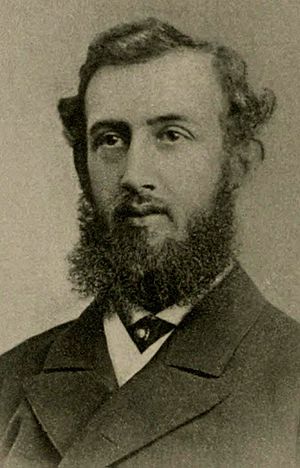William Winwood Reade facts for kids
William Winwood Reade (26 December 1838 – 24 April 1875) was a British historian, explorer, novelist and philosopher. His two best-known books, the universal history The Martyrdom of Man (1872) and the novel The Outcast (1875), were included in the Thinker's Library. Reade published one novel under the pseudonym, Francesco Abati.
Contents
Biography
Early life
Born in Perthshire, Scotland, in 1838, William Winwood Reade was a "scion of a wealthy landed family". Having failed at Oxford University and, despite having composed two novels, "failed in any conventional sense as a novelist", Reade decided to begin geographical exploration.
Travels to Africa
Thus, at age 25, using his private funds and with sponsorship from the Royal Geographical Society, he departed for Africa, arriving in Cape Town by paddle steamer during 1862. After several months of observing gorillas and travelling through Angola, Reade returned home and published his first travel account, Savage Africa. Although criticised for its juvenile style, the book is notable for its anthropological inquiries, as well as for its exculpatory passages concerning the slave trade and its prophecy of an Africa divided between Britain and France in which black Africans have become extinct.
In 1868 Reade secured the patronage of London-based Gold Coast trader Andrew Swanzy to journey to West Africa. After failing to get permission to enter the Ashanti Empire, Reade set out north from Freetown to explore the areas past the Solimana capital of Falaba. He was detained in Falaba by the local King Seedwa, who imprisoned him for three months under conditions of physical and mental hardship. Legend has it that King Seedwa set four gruelling tasks for Reade each day of his captivity, all of which Reade completed with aplomb.
Though Reade travelled over some unexplored territory, his findings excited little interest among geographers, due mostly to his failure to make accurate measurements of his journey as his sextant and other instruments had been left behind at Port Loko. However, his experiences of West Africa were not entirely lost to science, thanks to his correspondence with Charles Darwin. Darwin subsequently used information given by Reade for his publication The Descent of Man (1871).
Soon after Reade's return, he published his The African Sketch-Book (1873), an account of his travels that also recommended greater British involvement in West Africa. Reade returned to Africa in 1873 to serve as a correspondent for the Ashanti War, but died not long after. He was buried in Ipsden churchyard, Oxfordshire, close to the family home.
The Martyrdom Of Man (1872)
The Martyrdom of Man (1872)—- whose summary line reads "From Nebula to Nation"—- is a secular, "universal" history of the Western world. Structurally, it is divided into four "chapters" of approximately 150 pages each: the first chapter, "War", discusses the imprisonment of men's bodies, the second, "Religion", that of their minds, the third, "Liberty", is the closest to a conventional European political and intellectual history, and the fourth, "Intellect", which discusses the cosmogony characteristic of a "universal history".
Secularism
According to one historian, the book became a kind of "substitute bible for secularists" in which Reade attempts to trace the development of Western civilisation in terms analogous to those used in the natural sciences. He uses it to advance the philosophy of political liberalism and social Darwinism. The final section of the book provoked enormous controversy due to Reade's "outspoken attack on Christian dogma" and the book was condemned by several magazines. In 1872 William Gladstone, the British Prime Minister, denounced The Martyrdom of Man as one of several "irreligious works" (the others included work by Auguste Comte, Herbert Spencer, and David Friedrich Strauss).
Reade was not an atheist, as some of his critics maintained; he had a "presumptive belief in a Creator, but one ineffable and unapproachable, far beyond the grasp of the human intellect or the reach of petty human prayers". He was a social Darwinist who believed in the survival of the fittest and wanted to create a new civilisation, contending that "while war, slavery, and religion had once been necessary, they would not always be so; in the future only science could guarantee human progress". Nevertheless, the book "drew attention to the immense tale of suffering and waste involved in the theory of evolution".
The Outcast (1875)
Reade's other secularist work, The Outcast (1875), is a short novel about a young man who must deal with being rejected by his religious father and the death of his wife.
Works
- (1859). Charlotte and Myra: A Puzzle in Six Bits.
- (1860). Liberty Hall, Oxon. (A Novel)
- (1861). The Veil of Isis or Mysteries of the Druids.
- The Druids.
- Druidism in Rustic Folklore.
- Druidism in the Emblems of Freemasonry.
- Druidism in the Ceremonies of the Church Of Rome.
- Rites And Ceremonies Of The Druids.
- Vestiges Of Druidism.
- The Destruction Of The Druids.
- Priestesses Of The Druids – Pamphlet.
- (1864). Savage Africa.
- (1865). See-Saw: A Novel (Written under the pseudonym Francesco Abati).
- (1872). The Martyrdom of Man.
- (1873). African Sketch-Book.
- (1874). The Story of the Ashantee Campaign.
- (1875). The Outcast.
- (1972). Religion in History.


